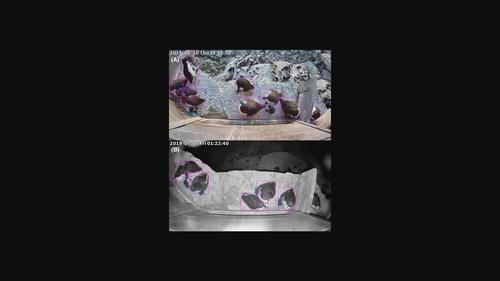海鸟监测:CCTV和人工智能相结合进行监测和研究
IF 3.9
2区 环境科学与生态学
Q1 ECOLOGY
引用次数: 2
摘要
生态研究和监测需要能够迅速传达信息,为科学合理的管理奠定基础。自动化传感器系统,特别是与人工智能相结合,可以实现如此快速的高分辨率数据检索。在这里,我们探索了自动化方法的前景,以产生对海鸟的见解,它们经常被监测,因为它们具有很高的保护价值,并且是海洋生态系统变化的哨兵。我们开发了一种结合自动图像处理的视频监控系统,并将其应用于常见的犯罪现场。该系统使用深度学习算法进行对象检测(YOLOv5),该算法已经在成年鸟类、小鸡和鸡蛋的注释图像上进行了训练,并在提供的视频材料中逐帧输出所有检测的时间、位置、大小和置信度。在三个完整的繁殖季节(2019-2021年)中,从繁殖悬崖共检测到1.44亿只鸟类。我们演示了如何使用目标检测来准确监测繁殖物候和小鸡生长。我们的自动化监测方法还可以识别和量化传统监测中容易遗漏的罕见事件,例如来自捕食者的干扰。此外,将自动视频分析与温度记录仪的连续测量相结合,使我们能够非常详细地研究热浪对巢率的影响。因此,我们的自动化系统产生了可比的数据,在某些情况下,比实地观测研究产生的数据更详细。通过在摄像机流上实时运行,它有可能为研究人员和管理人员提供有关海鸟种群状况的高分辨率最新信息。我们描述了如何修改该系统以适应各种类型的生态研究和监测目标,从而为保护和生态系统管理提供最新的支持。本文章由计算机程序翻译,如有差异,请以英文原文为准。

Seabird surveillance: combining CCTV and artificial intelligence for monitoring and research
Ecological research and monitoring need to be able to rapidly convey information that can form the basis of scientifically sound management. Automated sensor systems, especially if combined with artificial intelligence, can contribute to such rapid high‐resolution data retrieval. Here, we explore the prospects of automated methods to generate insights for seabirds, which are often monitored for their high conservation value and for being sentinels for marine ecosystem changes. We have developed a system of video surveillance combined with automated image processing, which we apply to common murres Uria aalge. The system uses a deep learning algorithm for object detection (YOLOv5) that has been trained on annotated images of adult birds, chicks and eggs, and outputs time, location, size and confidence level of all detections, frame‐by‐frame, in the supplied video material. A total of 144 million bird detections were generated from a breeding cliff over three complete breeding seasons (2019–2021). We demonstrate how object detection can be used to accurately monitor breeding phenology and chick growth. Our automated monitoring approach can also identify and quantify rare events that are easily missed in traditional monitoring, such as disturbances from predators. Further, combining automated video analysis with continuous measurements from a temperature logger allows us to study impacts of heat waves on nest attendance in high detail. Our automated system thus produces comparable, and in several cases significantly more detailed, data than those generated from observational field studies. By running in real time on the camera streams, it has the potential to supply researchers and managers with high‐resolution up‐to‐date information on seabird population status. We describe how the system can be modified to fit various types of ecological research and monitoring goals and thereby provide up‐to‐date support for conservation and ecosystem management.
求助全文
通过发布文献求助,成功后即可免费获取论文全文。
去求助
来源期刊

Remote Sensing in Ecology and Conservation
Earth and Planetary Sciences-Computers in Earth Sciences
CiteScore
9.80
自引率
5.50%
发文量
69
审稿时长
18 weeks
期刊介绍:
emote Sensing in Ecology and Conservation provides a forum for rapid, peer-reviewed publication of novel, multidisciplinary research at the interface between remote sensing science and ecology and conservation. The journal prioritizes findings that advance the scientific basis of ecology and conservation, promoting the development of remote-sensing based methods relevant to the management of land use and biological systems at all levels, from populations and species to ecosystems and biomes. The journal defines remote sensing in its broadest sense, including data acquisition by hand-held and fixed ground-based sensors, such as camera traps and acoustic recorders, and sensors on airplanes and satellites. The intended journal’s audience includes ecologists, conservation scientists, policy makers, managers of terrestrial and aquatic systems, remote sensing scientists, and students.
Remote Sensing in Ecology and Conservation is a fully open access journal from Wiley and the Zoological Society of London. Remote sensing has enormous potential as to provide information on the state of, and pressures on, biological diversity and ecosystem services, at multiple spatial and temporal scales. This new publication provides a forum for multidisciplinary research in remote sensing science, ecological research and conservation science.
 求助内容:
求助内容: 应助结果提醒方式:
应助结果提醒方式:


